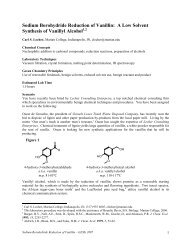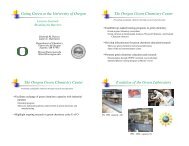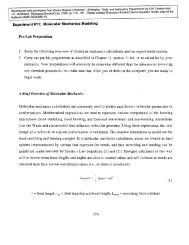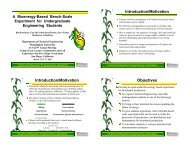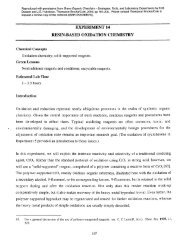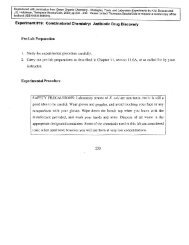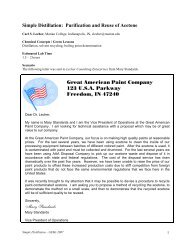Student Project - Gordon College - Green Chemistry
Student Project - Gordon College - Green Chemistry
Student Project - Gordon College - Green Chemistry
Create successful ePaper yourself
Turn your PDF publications into a flip-book with our unique Google optimized e-Paper software.
Summary Assessment Report<br />
Experiment: Hydrolysis of Post-Consumer Polylactic Acid Waste<br />
Background: This laboratory exercise was evaluated as part of the design of a hands-on<br />
workshop entitled Implementing <strong>Green</strong> <strong>Chemistry</strong> in the Laboratory for the Biannual Conference<br />
on Chemical Education delivered on Tuesday, July 29, 2008<br />
Workshop design focused on selecting a core of six laboratory exercises that could be<br />
implemented in a variety of learning contexts (general, organic, non-majors etc.) and be<br />
adapted to a “cooking show” format. This format was developed so that participants could set up<br />
the reactions and then work with previously prepared materials to complete the laboratory<br />
experience within 30 minutes.<br />
During the final phase of development, three undergraduate chemistry students from <strong>Gordon</strong><br />
<strong>College</strong> tested and optimized the revised laboratory procedures for the workshop during spring<br />
semester 2008. This work was completed as part of a <strong>Green</strong> Organic Literacy Forum (GOLuM)<br />
project associated with their sophomore organic chemistry course taught by Professor Irv Levy<br />
at <strong>Gordon</strong> <strong>College</strong>.<br />
• Bethany Corcoran, <strong>Gordon</strong> <strong>College</strong><br />
• Zackary Schwamb, <strong>Gordon</strong> <strong>College</strong><br />
• Christopher Tanga, <strong>Gordon</strong> <strong>College</strong><br />
This BCCE workshop was collaboratively designed, tested, and delivered by members of the<br />
<strong>Green</strong> <strong>Chemistry</strong> Education Network (GCEdNet) and undergraduate chemistry students at<br />
<strong>Gordon</strong> <strong>College</strong>. The <strong>Green</strong> <strong>Chemistry</strong> Education Network (GCEdNet) serves as a catalyst for<br />
integrating green chemistry in chemical education at all levels. As a network of educators, we<br />
support opportunities to research, develop, implement and disseminate green educational<br />
materials. The GCEdNet reaches out to all chemistry educators through collaborating and<br />
mentoring, facilitating professional growth, and fostering the synergistic integration of green<br />
chemistry in education.<br />
Experiment: Hydrolysis of Post-Consumer Polylactic Acid Waste 1
Experiment: Hydrolysis of Post-Consumer Polylactic Acid Waste<br />
Reviewed by: Zack Schwamb, organic chemistry student at <strong>Gordon</strong> <strong>College</strong> and submitted to<br />
GEMs May 2008.<br />
Assessment Summary (number of replications = 2)<br />
Answer the following on a scale of 1-5 where 1 is strongly disagree and 5 is strongly agree.<br />
Lowest to Highest<br />
As I prepared the method, it was very clear: 1 2 3 4 5<br />
The method worked as expected when I performed it: 1 2 3 4 5<br />
The method worked as expected when I ran it for someone else: 1 2 3 4 5<br />
This is a useful way to introduce principles of green chemistry: 1 2 3 4 5<br />
The estimated time was consistent each time I performed it: 1 2 3 4 5<br />
Cost of starting materials:<br />
Item Name Cost Unit<br />
PLA cups free Dependent on size of cups<br />
Sodium Hydroxide pellets $36 100 grams<br />
50% Ethanol $25 1 liter ethanol<br />
50% HCl (6 HCl) $15 250 grams/liter HCl<br />
Safety concerns: safety data was found from http://www.chemexper/.<br />
NaOH<br />
• C: Corrosive<br />
• 35: Causes severe burns<br />
• 26: In case of contact with eyes, rinse immediately with plenty of water and seek medical<br />
advice<br />
• 37/39: Wear suitable gloves and eye/face protection<br />
• 45: In case of accident or if you feel unwell, seek medical advice immediately (show the<br />
label where possible<br />
HCl<br />
• C: Corrosive<br />
• 34: Causes burns<br />
• 37: Irritating to respiratory system<br />
• 26: In case of contact with eyes, rinse immediately with plenty of water and seek<br />
medical advice<br />
• 45: In case of accident or if you feel unwell, seek medical advice immediately (show the<br />
label where possible)<br />
Experiment: Hydrolysis of Post-Consumer Polylactic Acid Waste 2
Ethanol<br />
• F: Highly flammable<br />
• 11: Highly flammable<br />
• 20/21/22: Harmful by inhalation, in contact with skin and if swallowed<br />
• 68/20/21/22: Harmful: possible risk of irreversible effects through inhalation, in contact<br />
with skin and if swallowed.<br />
• 7: Keep container tightly closed<br />
• 16: Keep away from sources of ignition- no smoking<br />
• 36/37: Wear suitable protective clothing and gloves<br />
• 45: In case of accident or if you feel unwell, seek medical advice immediately (show the<br />
label where possible)<br />
Safety<br />
• Sodium hydroxide is corrosive to the skin. Goggles and gloves should be worn<br />
throughout the experiment.<br />
• Hydrochloric acid is also harmful and corrosive. Goggles and gloves should be worn<br />
when handling this chemical.<br />
• Ethanol is not extremely harmful or corrosive. However, to be safe goggles and gloves<br />
should be worn to remain safe and protected.<br />
Quantity of hazards and waste: This measurement can vary between experiments depending<br />
on how much ethanol and HCl is added to the solution.<br />
Special equipment/materials needed: Besides the PLA cups and a hot plate with a magnetic<br />
stirrer, there is no special equipment necessary for the experiment to be run.<br />
Materials:<br />
• PLA cup<br />
• 250 mL Erlenmeyer flask<br />
• 500 mL beaker<br />
• Sodium hydroxide pellets<br />
• 50% HCl (6 M HCl)<br />
• 50% ethanol<br />
• Magnetic stir bar<br />
• Hot plate with a magnetic stirrer<br />
• Stirring rod<br />
• Watch glass<br />
• pH paper or meter<br />
• Filter paper<br />
• Equipment necessary for a vacuum filtration<br />
• Scale<br />
Notes/Comments: The actual lab time for the experiment was about an hour and a half to two<br />
hours. As a result, if this was done as a presentation for others within a 15-20 minute window,<br />
multiple experiments must be going on at different steps. This would skip long periods of waiting<br />
and mixing, and would make presenting to an audience easier to handle. Possibly 3-4<br />
experiments may need to go on at once.<br />
A few areas of the experiment worth pointing out are about the 50% HCl and the alternative step<br />
of using a microwave. There is no such thing as 50% HCl and this may be confusing for some to<br />
figure out. It would be more clear to write 50% HCl as 6 M HCl instead. In step 8a there is the<br />
Experiment: Hydrolysis of Post-Consumer Polylactic Acid Waste 3
alternative step of using a microwave to speed up the chemical process. I did not try this step in<br />
my own experiments because it seemed too dangerous. It does not seem like a very good idea<br />
to put a solution with alcohol into a microwave. This could be dangerous.<br />
Although listed in the above procedure, I did not do step 11 and recommend that it not be done<br />
during demonstration. Performing step 11 would take up a lot of time and would result in the<br />
experiment being well over two hours.<br />
Besides the notes above, the experiment extremely well and ran very smoothly. It is very clear<br />
and easy to follow and understand. It is also a great example of green chemistry.<br />
Hydrolysis of Post-Consumer Polylactic Acid Waste (tested base hydrolysis procedure)<br />
1. Measure 5.0 g (0.07 mol) of shredded PLA<br />
2. Measure 5.6 g (0.14 mol) of NaOH<br />
3. Retrieve a 250 mL Erlenmeyer flask<br />
4. Have the Erlenmeyer flask containing a magnetic stir bar<br />
5. Put everything into the Erlenmeyer flask<br />
a. When the PLA is added to the base hydrolysis solution, the chips of PLA should<br />
go into solution relatively quickly. If not, then you have not performed the correct<br />
stoichiometric calculation for adding the appropriate amount of base to react with<br />
all of the PLA<br />
6. Add enough 50% ethanol to cover the contents in the flask<br />
7. Cover the mouth of the flask with a small watch glass<br />
8. Heat the reaction to a brisk boil with constant stirring for one hour to ensure complete<br />
hydrolysis of the PLA<br />
a. Alternatively, you can use a household microwave to speed up the process.<br />
Microwave the reaction mixture on high for no more than 4 minutes at a time.<br />
Allow the reaction to cool for 4 minutes before repeating the process. 4 to 5<br />
cycles are generally required on a 650 Watt household microwave. Use of a<br />
microwave with a turntable is recommended<br />
9. Cool the reaction in an ice bath and acidify the resulting solution to a pH of 3.8 using<br />
50% HCl using pH meter<br />
10. Filter the cold solution to remove any residual particulate matter<br />
a. The filtrate is an aqueous solution of lactic acid and NaCl<br />
11. Water, ethanol and NaCl can be removed by rotary evaporation followed by vacuum<br />
filtration<br />
Experiment: Hydrolysis of Post-Consumer Polylactic Acid Waste 4




